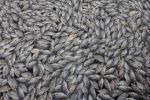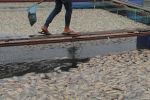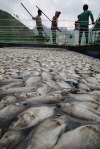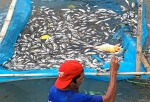Indonesia: Why did millions of fish turn up dead in Indonesia’s giant Lake Toba?
A village of aquafarmers grapples with the aftermath of a mass fish death that nearly killed the local economy. Is it too late to prevent a repeat of the catastrophe from occurring?
By Aria Danaparamita, 30th August 2016;
- In May, millions of fish died suddenly in the Haranggaol Bay of Lake Toba, Indonesia’s largest lake. Scientists chalked it up to a sudden depletion of oxygen in the water, the result of a buildup of pollutants in the lake, unfavorable weather conditions and unsustainable practices by local aquafarmers.
- The local economy was badly shaken by the incident. Most residents of Haranggaol village rely on the fish farms as their only dependable source of income. Many villagers have had to go into debt to keep their businesses from collapsing.
- Haranggaol residents have since tried to modify their practices to prevent another die-off, but without the resources and know-how of the lake’s corporate aquafarmers, they have had a difficult time.
- Meanwhile, the government has big plans for Lake Toba as a tourist destination along the lines of a “Monaco of Asia” — one that might not include the unsightly fish farms.
On the morning of May 4, the fish farmers of Haranggaol were waking up to feed the Tilapia (Oreochromis sp.) and Carp (Cyprinus carpio) they raise in floating cages here on Indonesia’s Lake Toba. But when they got to the shore, the lake was gleaming white with fish carcasses.
“We were going to feed them, but the fish already died,” 39-year-old Mariando Nainggulan told Mongabay one recent evening in the village, home to 3,200 people.
Mariando, one of Haranggaol’s biggest aquafarmers, said he lost over 1 billion rupiah ($75,000) and had to borrow that amount from a bank to keep his business afloat. “It was sudden,” he said. “Of course I was sad. And of course I was confused.”
An estimated 1,500 tons of Tilapia and Carp perished in the first mass fish death to hit Toba, Indonesia’s largest lake, since 2004, when its Carp stock was demolished by the koi herpes virus.
This time, researchers pinned the blame on a depletion of oxygen in the water, brought on primarily by an excess of sewage, detergents, fertilizer — and fish feed. Met with overcrowded fish cages and unfavorable weather, the conditions became fatal.
It wasn’t the country’s first mass fish asphyxiation — notable incidents have occurred in West Sumatra’s Lake Maninjau and in the reservoirs of West Java — but it was the first time it happened in Lake Toba, according to a government agency that analyzed the Haranggaol incident.
Scientists have long warned that pollution in the lake is reaching untenable levels — and the Haranggaol fish kill may be the canary in the coal mine.
Surrounded by scenic mountains in North Sumatra province, Lake Toba was once a booming tourist destination. Formed by a volcanic caldera, the lake drew domestic and foreign visitors with its clear water.
But in the last two decades, tourism has slowed to a trickle, and even locals say that water in parts of the lake is no longer fit for drinking or swimming.
A damaged lake
In 2014, Bogor Agricultural University researchers classified the lake as eutrophic, meaning it had become excessively rich in nutrients like nitrogen and phosphorus — and prone to oxygen-devouring algal blooms. The Environment and Forestry Ministry’s inquiry into the May fish kill found that the lake’s phosphorus content had tripled since 2012.
The nutrient loading was worst near the floating cages, where large amounts of fish feed containing phosphorus, an essential element for fish growth, are daily dropped into the lake.
“Aquaculture shouldn’t be solely blamed for lake pollution,” Josh Oakley, an environmental specialist who studied the lake’s carrying capacity for aquaculture production, told Mongabay. Pollutants come from a variety of sources, such as agricultural runoff and sewage from houses and hotels.
Still, “The uncontrolled rising number of floating cages has caused grave environmental problems,” the Indonesian Institute of Sciences (LIPI) concluded in a report about the fish kill. “The number keeps rising, and is thought to have far exceeded the ecosystem’s carrying capacity.”
The 1,130-square-kilometer Lake Toba produces an estimated 76,000 metric tons of aquaculture products a year, much of it from local farmers. Two companies — Swiss-owned PT Aquafarm Nusantara and PT Suri Tani Pemuka, an arm of the Singapore-listed Japfa Group — also cultivate Tilapia on the lake and export fillets internationally, including to the U.S. and Europe.
PT Aquafarm — responsible for 40,000 tons of production in 2015 — has come under fire for introducing waste into the lake.
Haranggaol, the lake’s second-largest source of farmed fish, has also been criticized for pollution. Where in 2005 the village had 854 floating pens, today there are over 6,000. But that explosion, while a boon to the local economy, has come at a cost.
Sitting on an inlet ringed by steep hills on the lake’s northeastern edge, Haranggaol Bay is dominated by vast rows of steel-framed net cages across its 3-square-kilometer surface.
The bay’s small size and relatively calm waters means it particularly struggles to absorb all the effluents it receives. In a paper for the University of Rhode Island, Oakley determined its phosphorus concentration to be an average total of 110 milligrams per cubic meter, placing the bay “well beyond hyper-eutrophic status.”
The presence of domestic wastewater alone, he found, made it impossible for the bay to return to a preferred oligotrophic state, in which the water is low in nutrients and high in oxygen.
To achieve the next best thing — a mesotrophic condition — Haranggaol would need to drastically cut its fish production to only 20.12 tons per year, Oakley wrote. That’s a sharp cut from the estimated 27,000 tons it currently produces. Oakley notes that adopting more sustainable practices can help raise that production capacity. But even with the most optimal practices, Haranggaol would still only be able to farm 51.85 tons per year, he wrote.
Meanwhile, the environment ministry in Jakarta has called for a 44 percent cut in aquaculture production lakewide.
A military crackdown
The government has long struggled to curb the rise of unregulated community fish farms. A 2014 presidential edict stipulated that aquaculture would only be allowed in one district: Toba Samosir.
The campaign against fish farming ramped up in recent months after President Joko Widodo announced a plan to turn Toba — dubbed the “Monaco of Asia” — into a major tourist destination.
Local governments have wasted no time in carrying out the mandate. In late July, Simalungun district — which also covers Haranggaol — dispatched military and police officers to dismantle cages in Sualan village, about 70 kilometers south of Haranggaol.
After pleas from local fish farmers, the government agreed to postpone the eviction. Instead, the seven districts on the lake and the provincial government agreed on new zoning regulations, while asking the farmers to adhere to stricter environmental standards.
“Not zero — there are zones where they will be allowed so it is safe for the environment,” Mixnon Andreas Simamora, head of Simalungun’s development agency, told Mongabay.
Haranggaol is included as a fish farming zone. Still, news of the military operation in Sualan sent waves of panic to the village.
That, on top of the mass death, led the Haranggaol fish farmers to worry about what their future would look like.
A village of fish farmers
Haranggaol, a four-drive drive from Sumatra’s largest city, Medan, turned to fish farming in the 1980s after a virus wiped out its previous crops: onions and garlic.
“Haranggaol was threatened with starvation. Some wise people tried to farm fish,” said Hasudungan Siallagan, 45, head of the local fish farmers’ association.
Now, Hasudungan said, about 80 percent of the village relies on fish farming. “That includes laborers: net workers, delivery workers, they all live from the cages.”
For many of the villagers who don’t own land to farm, fish farming is currently their only dependable source of income. Many fund their businesses by taking out bank loans. Losing or severely reducing aquaculture would not only disrupt the families’ income — it would leave them under massive debt.
After the die-off, the farmers were forced to halt fish deliveries to local markets, and did not put in new crop for a month. Villagers rented trucks and machinery and banded together to bury the fish in a hillside mass grave.
In addition to the economic shock, the mass death forced Haranggaol’s fish farmers to reconsider the environmental impacts of their practices.
“The farmers don’t know good aquaculture techniques. We didn’t even know the carrying capacity per meter,” Hasudungan said, explaining that they mostly learned through trial and error.
After the fish kill, the villagers scrambled to find solutions to prevent another disaster.
“After the incident, we began to correct our practices,” Mariando said. “We rearranged the cages. Then we reduced the number of fish in the cages. We don’t put in 15,000 per cage anymore — just around 5,000 each cage. And the effect is visible: fish death has been significantly reduced.”
Yet to have any real impact on restoring the water quality, the farmers need to do a lot more than that.
‘Of course I’m worried’
It’s not just local farmers feeling the pressure to be more environmentally conscious. PT Suri Tani Pemuka, which also operates farming sites in Simalungun district, is experimenting with new cleaning technology.
The company began farming fish in the lake in 2012 and produced around 4,000 tons of fish in 2015.
Since last year, it has imported 12 “lift-up” cleaning systems from Norway to vacuum waste and dead fish from the net bottoms. The company also uses broadcaster machines that shoot out feed at a pre-programmed rate to reduce the amount of wasted pellets. And it’s working to reduce the phosphorus content of the Comfeed brand of pellets it produces, which is also sold to farmers.
“We do this because what is good for the environment is good for fish, and what is good for fish is good for the company,” Jenny Budiati, the company’s head of seafood processing, told Mongabay.
But although such innovations might be promising, local farmers who can’t afford Norwegian machinery are unlikely to replicate them in their own makeshift cages.
In his paper, Oakley outlined that certain practices could help increase Haranggaol’s carrying capacity. This includes placing the cages further offshore, where the water is deeper and currents can help maintain a healthier flow of oxygen and disperse waste. Farmers could also select feed that contains less phosphorus and ensure that fewer pellets are wasted.
In mid-August, PT Suri Tani Pemuka representatives held a workshop in Haranggaol on feeding practices and cage maintenance. But economic constraints are making it difficult for the Haranggaol farmers to make changes, even something as simple as switching to floating pellets with low phosphorus content since those cost more.
Since the mass death in May, the villagers have reorganized their previously haphazardly laid-out cages. Now the cages are arranged in lines, with some extending further offshore than before. That move alone cost the villagers the money they had saved to fix potholed roads in the village.
The Haranggaol farmers said they haven’t been told of any concrete plans from the government to help or incentivize local farmers to make their cages more sustainable.
“What does ‘environmentally friendly’ mean? What does that look like?” Hasudungan asked. “They have offered no solutions.”
Then again, improving fish farming is only one part of the solution. Haranggaol — and the lake region at large — must figure out better ways to treat pollutants from other sources.
Meanwhile, the question looms of whether Haranggaol’s pollution is so dire that large-scale fish farming simply can’t coexist with Lake Toba’s tourism dreams even with the most sustainable practices, as Oakley’s modelling suggests.
And while sustainability remains an elusive aim, Mariando says he has to think far more short-term: the two-month-old fish he’s currently growing in his nets.
“Of course I’m worried,” he said of continuing to farm in the wake of the die-off. “I’m waiting to harvest by the new year. Hopefully.”
























